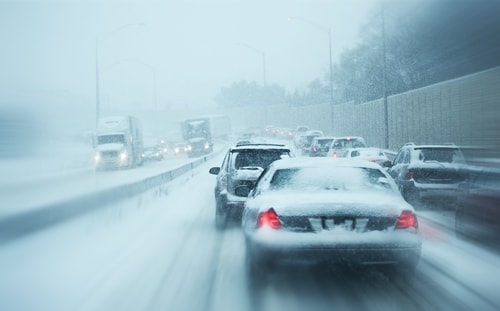CHICAGO, IL – As winter sets in across Chicago, the roads become more treacherous, and drivers face an increased risk of accidents. With freezing temperatures, snow, ice, and reduced visibility, winter driving requires extra caution. Whether you’re navigating snow-covered streets or dealing with the unpredictable weather that characterizes Chicago winters, it’s important to understand the common hazards and take steps to stay safe.
Common Winter Driving Hazards in Chicago
Slippery roads are one of the most dangerous hazards Chicago drivers face in winter. Snow and ice can accumulate quickly, making driving conditions hazardous. Black ice, a thin and nearly invisible layer of ice, often forms early in the morning or late at night and can be especially dangerous. It is most common on bridges, overpasses, and shaded areas. Drivers need to be especially vigilant for this hidden danger, as it’s easy to slip and lose control of your vehicle.
Another significant risk during the winter months is reduced visibility. Snowstorms, fog, and other weather conditions can drastically limit how far you can see. Snow buildup on windshields and mirrors can also obscure your view, making it difficult to navigate safely. During snowstorms, the visibility of other vehicles may also be compromised, increasing the likelihood of accidents. Always make sure your car’s defrost and wipers are functioning before hitting the road.
The cold temperatures that come with Chicago winters can also cause problems with your vehicle. Cold weather can lead to engine trouble, battery failure, or even flat tires. These issues can leave you stranded or unable to get to your destination, making it essential to ensure your car is properly maintained for winter conditions.
In addition to mechanical problems, cold weather also increases stopping distances. Snow and ice can affect your vehicle’s braking system, making it harder to slow down or stop quickly. On slippery surfaces, it’s important to drive more cautiously and leave extra space between your car and others to avoid rear-end collisions.
Snow and ice that accumulate on your vehicle can pose a danger not just to you, but to other drivers as well. If you don’t clear off your car before driving, snow or ice can slide off and create hazards for other vehicles. Always take the time to clear your car of snow, particularly from the roof, hood, and windshield, before heading out on the road.
Tips for Safe Winter Driving
Before heading out during winter, it’s essential to ensure your vehicle is prepared for the cold. Have your car’s battery and tires checked and replaced if needed, and make sure your windshield wipers are in good condition. Keep your gas tank at least half full to avoid freezing fuel lines, and fill up your windshield washer fluid reservoir regularly. These simple steps can help avoid mechanical issues when you need your car the most.
When driving in winter conditions, it’s critical to reduce your speed. Driving slowly will give you more time to react to unexpected conditions and hazards. Sudden braking, accelerating, or turning can cause your tires to lose traction, so try to drive smoothly and cautiously. Pay attention to road conditions and adjust your speed accordingly. If the roads are particularly slippery, consider driving even slower than usual to ensure your safety.
It’s also essential to give yourself more space between your car and the one ahead of you. In winter conditions, stopping distances are longer, and sudden changes in speed can be dangerous. Allow extra room for braking, and don’t tailgate. This space will give you more time to react to any hazards that may arise, such as a vehicle stopping suddenly or a patch of black ice.
Using your headlights during winter weather is another important safety tip. Fog, snow, and even overcast skies can reduce visibility, so keep your headlights on during the day as well as at night. This will help you see the road better and also ensure other drivers can see you, reducing the risk of collisions.
In the event that your vehicle starts to skid on icy roads, it’s important to stay calm. Rather than panicking, steer gently in the direction you want to go. Avoid slamming on the brakes, as this can make the skid worse. If you need to brake, do so gently to avoid losing traction. Keeping your cool can help you regain control and stay safe on the road.
Finally, it’s always a good idea to be prepared for emergencies, especially in the event that you become stranded. Pack an emergency kit with essentials like blankets, water, non-perishable food, a flashlight, jumper cables, and a first aid kit. These items can make a difference in case of an unexpected situation.
What to Do After a Winter Accident
Despite taking precautions, accidents can still happen. If you’re involved in a winter-related accident, stay at the scene and call the police. Exchange information with the other driver, including insurance details, and take photos of the damage to your vehicle and the accident scene. Even if you don’t feel any immediate pain, seek medical attention, as some injuries from car accidents may not be apparent right away.
If you’ve been injured or believe the accident was caused by another driver’s negligence, it’s important to consult with an experienced personal injury attorney. An attorney can help you understand your rights, guide you through the legal process, and ensure you receive the compensation you deserve for your injuries or damages.
Contact a Personal Injury Lawyer in Chicago, Illinois
Driving in Chicago during the winter months presents unique challenges, but with the right precautions, you can reduce your risk of an accident. Take the time to prepare your vehicle, drive cautiously, and remain aware of changing road conditions. If you find yourself involved in an accident, don’t hesitate to contact the Dinizulu Law Group to seek legal advice to protect your rights and secure the compensation you may be entitled to.



